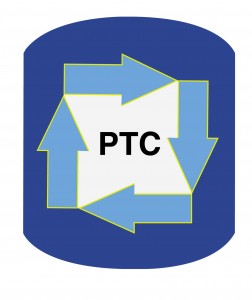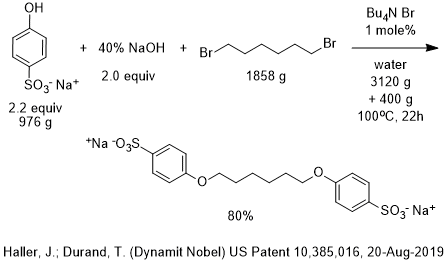The patent cited in the diagram reacted sodium 4-hydroxybenzene sulfonate with 1,6-dibromohexane at 100 C and achieved 80% yield. Page 180 of the PTC course manual of “Industrial Phase-Transfer Catalysis” teaches two PTC patents for the reaction of the same reactant, sodium 4-hydroxybenzene sulfonate, but with a chloroformate at 120-130 C that both achieve 95% yield. The PTC patent that was issued first using chloroformate had a big hole in the claims which the second PTC patent filled. We use the comparison of these two PTC patents to teach how to write tight claims for PTC patents and avoid a costly PTC patent mistake.
Two big differences between the procedures using bromohexane and chloroformate with the same phenol sulfonate salt are the use of NaOH and the careful selection of water content. This is not surprising considering the fact that bromohexane is much less water sensitive than the chloroformate.
In the Aug 2019 patent shown in the reaction diagram, the inventors used 2 equiv NaOH to neutralize the 2 equiv of phenolic O-H. This avoids excess hydroxide which could dehydrobrominate the dibromohexane.
One lesson from the 2 PTC patents that reacted chloroformate with the phenol sulfonate salt that may have been applied by the inventors of the reaction using dibromohexane, was to optimize the water content of the reaction. It appears that the inventors used the minimum amount of water in the first stage of the reaction until it became too difficult to stir and only then did they add an extra 400 g of water to complete the reaction. Using less water under solid-liquid PTC conditions, increases the reaction rate as we teach on pages 81-87 of the PTC course manual.
It is common that companies miss opportunities to reduce cost for challenging PTC applications by not being aware of concepts that PTC experts implement routinely. You now have a rare opportunity to learn the best PTC technology in a public PTC course on October 15-16, 2019 in Prague that will be taught by Marc Halpern of PTC Organics. Alternatively, now contact Marc Halpern of PTC Organics for PTC process consulting to integrate highly specialized expertise in industrial phase-transfer catalysis with your company’s commercial process development goals and achieve low-cost high-performance green chemistry using phase-transfer catalysis.


